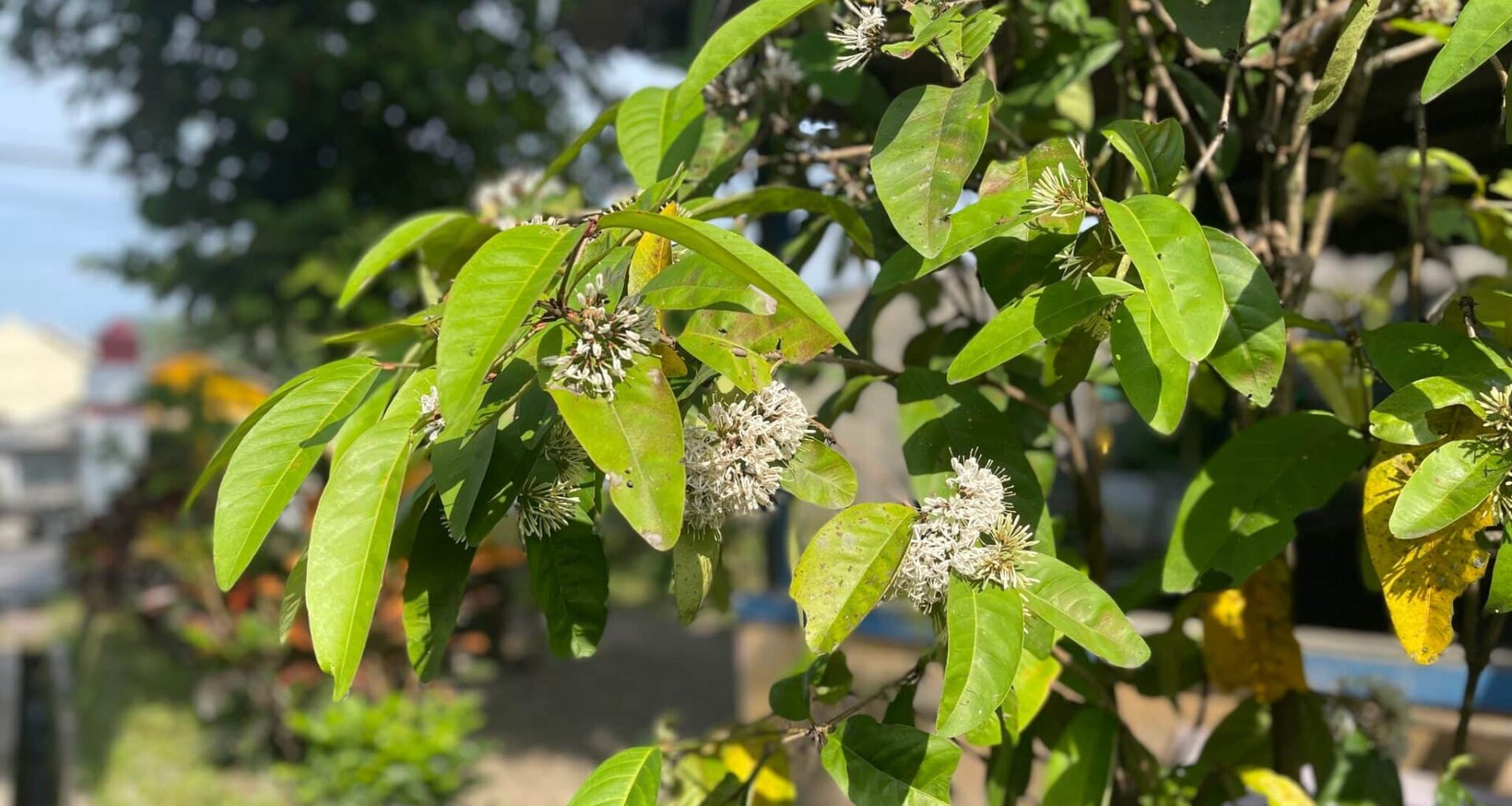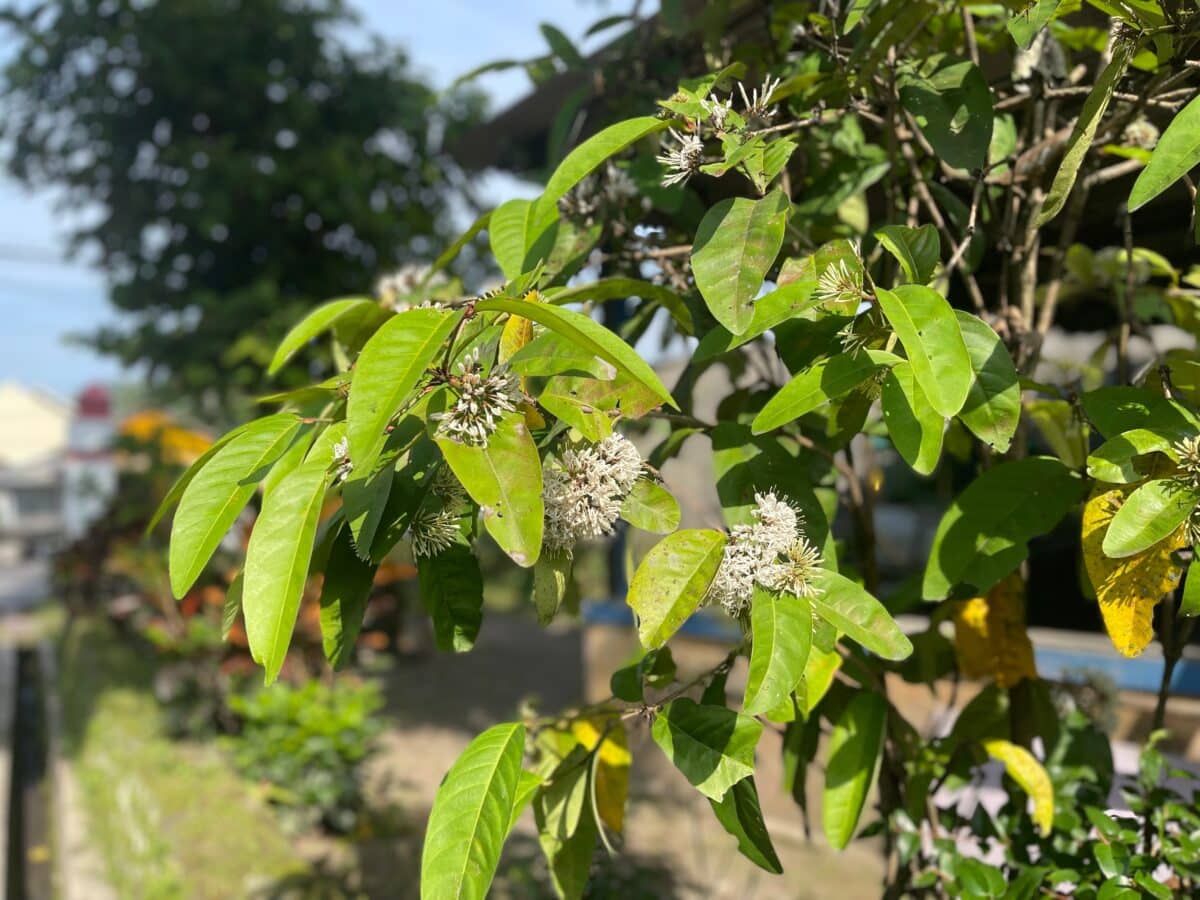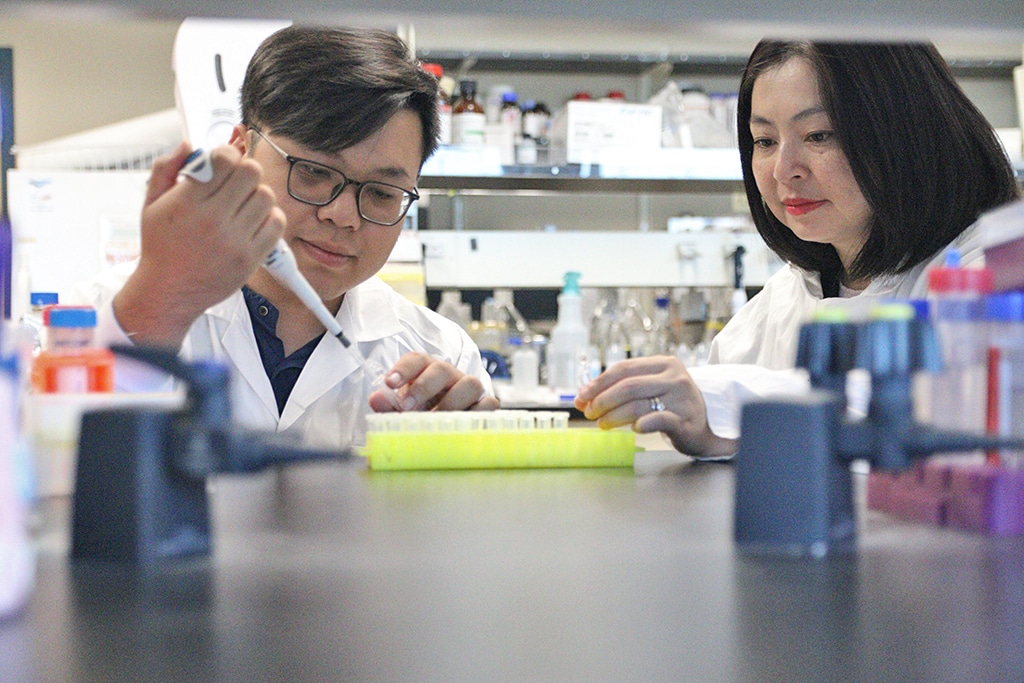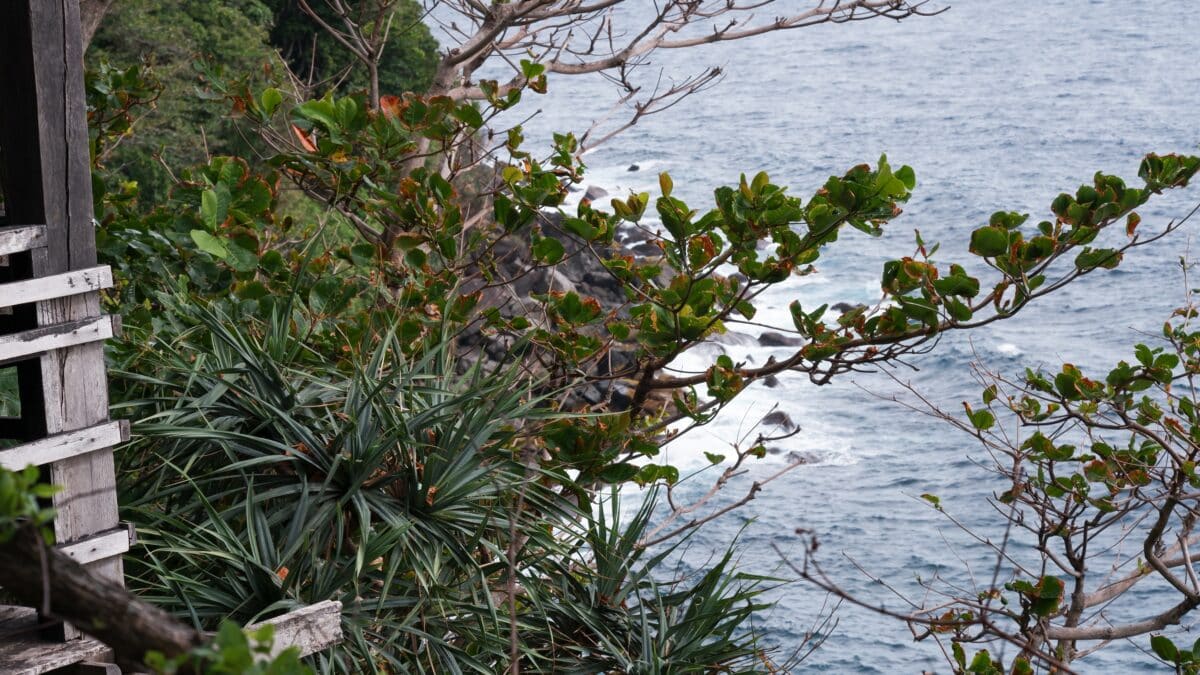Mitragyna Parvifolia tree. (Credit: Haena148 on Shutterstock)
In A Nutshell
- Scientists mapped the Mitragyna parvifolia genome and identified three enzymes that build mitraphylline from ajmalicine.
- Young leaves hold the highest levels of mitraphylline and show strong activity of the pathway genes.
- The genome is allotetraploid, which helps explain diverse alkaloids across this plant group.
- Running the pathway in tobacco suggests a path to controlled, lab-based production for research.
KELOWNA, British Columbia — Scientists have cracked the genetic code of a little-known tree from India that makes a rare compound showing antiproliferative activity in human cancer cell models.
Researchers at the University of British Columbia and the University of Florida mapped out the complete DNA blueprint of Mitragyna parvifolia, a tropical tree native to the Indian subcontinent, and pinpointed exactly how it manufactures mitraphylline. This spirooxindole alkaloid has unusual “twisted” ring structures and past studies have shown it can inhibit growth across several human cancer cell lines in laboratory dishes.
Despite their promise as anti-tumor and anti-inflammatory agents, the molecular steps plants use to make spirooxindoles remained a mystery until now. The discovery, published in The Plant Cell, could make it easier to produce this compound for medical research.
M. parvifolia is a close relative of kratom, the Southeast Asian tree that has drawn controversy for its psychoactive alkaloids. But while kratom makes mostly mitragynine, M. parvifolia focuses on churning out mitraphylline instead, giving it a distinct alkaloid profile.
3 Enzymes Work Like a Molecular Assembly Line
The research team identified three enzymes that had never been seen before, each doing one step in the manufacturing process.
“This is similar to finding the missing links in an assembly line,” says Dr. Thu-Thuy Dang, UBC Okanagan Principal’s Research Chair in Natural Products Biotechnology, in a statment. “It answers a long-standing question about how nature builds these complex molecules and gives us a new way to replicate that process.”
The first two enzymes, working as a pair, take a starting chemical called ajmalicine and flip its molecular structure like a mirror image, from the (3S) form to (3R)-epi-ajmalicine. The third enzyme then reshapes this flipped version into mitraphylline. Laboratory tests showed this third enzyme could not produce spirooxindoles from the unflipped form, confirming it requires the specific mirror-image version.
Doctoral student Tuan-Anh Nguyen led the effort to identify this enzyme pair. Building on a 2023 breakthrough when Dr. Dang’s group found the first plant enzyme that can twist a molecule into the spiro shape, Nguyen’s work completed the picture.
To prove they’d found the right recipe, researchers inserted these genes into tobacco plants and fed them ajmalicine. The tobacco plants successfully made mitraphylline, confirming the team had identified the complete assembly line.
UBC Okanagan doctoral student Tuan-Anh Nguyen, left, and Dr. Thu-Thuy Dang examine plant samples in their lab. Their research has uncovered how tropical trees produce mitraphylline, a rare compound with potential anti-tumour properties. (Credit: UBC Okanagan)
Young Leaves Concentrate the Compound
Natural compounds are often found in very small amounts in plants, making them difficult or costly to reproduce in the lab. Mitraphylline occurs only in trace amounts in tropical trees like Mitragyna (kratom) and Uncaria (cat’s claw), members of the coffee family.
The tree stores most of its mitraphylline, along with strictosidine and ajmalicine isomers, in young leaves, where the production genes work overtime. This is likely where the plant focuses its chemical defenses against insects and other threats.
The research also showed that M. parvifolia has four copies of every chromosome instead of the usual two, making it what geneticists call a tetraploid. This chromosome doubling happened in the tree’s evolutionary past and may explain why different species in the Mitragyna family produce such different mixes of chemicals.
By identifying enzymes that build and shape mitraphylline, researchers now have a roadmap for producing it and related compounds in sustainable ways. Now that scientists know which genes make mitraphylline, they could engineer bacteria, yeast, or plants to produce it. This could provide a steady, controlled supply for researchers studying the compound’s medical potential.
Ancient DNA Doubling Event Shaped Chemical Diversity
The genetic map covers 778.7 million base pairs organized into 22 pseudochromosomes, with 92.6% of the assembly placed in pseudochromosomes. The team identified over 50,000 genes, and they know what roughly seven out of ten of those genes do.
When they compared M. parvifolia’s DNA to related plants, they found evidence that the Mitragyna family underwent major expansions in genes for making defensive chemicals. These changes help explain the chemical variety found across the coffee family of plants, which includes not just M. parvifolia but also coffee plants and the trees that produce quinine for treating malaria.
The enzyme that makes the final step to mitraphylline belongs to a protein family found only in certain Cinchonoideae branches (M. speciosa, M. parvifolia, Uncaria rhynchophylla, Cinchona pubescens).
“Plants are fantastic natural chemists,” Dr. Dang says. “Our next steps will focus on adapting their molecular tools to create a wider range of therapeutic compounds.”
For now, M. parvifolia remains in the shadow of its famous kratom cousin. But this genetic roadmap might change that as scientists work to understand what makes its chemistry unique.
Leaves of a helamba tree (or Mitragyna parvifolia) from the top of a cliff, against a backdrop of ocean waves at the tip of the island of Weh, Indonesia. (Credit: f.maliki)
Disclaimer: This article summarizes basic scientific research. It is general information for readers and is not medical advice, diagnosis, or treatment guidance.
Paper Summary
Methodology
Scientists extracted DNA from young M. parvifolia leaves and read the genetic sequence using two different technologies: long-read sequencing that captured large DNA chunks and short-read sequencing for accuracy checking. They assembled these fragments into a complete genome using specialized computer programs, then organized everything into chromosome-level sections using a technique that shows which DNA pieces sit physically close together in the cell. The team identified which sections code for genes by comparing them to genetic information from five different tissue types: young leaves, mature leaves, stems, roots, and stipules. They compared this genome to 12 other plant species to understand evolutionary relationships. To test which genes make mitraphylline, they artificially inserted candidate genes into tobacco plants, fed the plants ajmalicine, and checked whether mitraphylline appeared using laboratory analysis equipment.
Results
The final genetic map totaled 778.7 million base pairs organized into 22 pseudochromosomes, with 92.6% successfully placed. The assembly scored very high on quality checks. About half the genome consists of repetitive DNA sequences, mostly a type called Gypsy elements. The team identified 50,187 genes with high completeness scores. Comparing genes across species showed that M. parvifolia and related plants experienced a major chromosome doubling event about 30 million years ago, which seems to have driven the creation of diverse alkaloid-making systems. Chemical analysis showed young leaves contain the most strictosidine, ajmalicine variants, mitraphylline, and isomitraphylline. Gene activity studies pointed to three key enzymes. Laboratory tests confirmed that two enzymes working together convert one form of ajmalicine to its mirror-image version, which a third enzyme then converts to mitraphylline and isomitraphylline. These enzymes also worked on similar starting chemicals, producing various related compounds.
Limitations
The researchers noted several challenges. The final genome assembly was larger than computer models had predicted, likely because some duplicate DNA sections weren’t fully removed during analysis. This showed up as extra gene copies in quality checks. The scientists also had difficulty pinpointing exact evolutionary relationships between M. parvifolia and closely related species, probably because these plant groups diverged relatively quickly over time. The study didn’t determine every detail of how the newly discovered enzymes work, including their exact three-dimensional structures or operating speeds. While the team identified the three main enzymes that make mitraphylline, other helper enzymes may exist that haven’t been discovered yet.
Funding and Disclosures
The research received support from the U.S. Department of Agriculture-National Institute of Food and Agriculture (project 2024-67013-42711 to Nadakuduti), the National Sciences and Engineering Research Council Alliance International Collaboration (ALLRP 597402-24 to Dang), Michael Smith Health Research BC (SCH-2020-0401 to Dang), and the National Institute on Drug Abuse (R01 DA047855 and UG3 DA048353 to McCurdy and colleagues). The University of Florida provided additional sequencing support. The authors reported no conflicts of interest.
Publication Details
Laforest LC, Nguyen TAM, Matsumoto GO, Ramachandria P, Chanderbali A, Kanumuri SRR, Sharma A, McCurdy CR, Dang TTT, Nadakuduti SS. “A chromosome-level Mitragyna parvifolia genome unveils spirooxindole alkaloid diversification and mitraphylline biosynthesis,” published in The Plant Cell. 2025;37(9):koaf207. Published online August 18, 2025.



